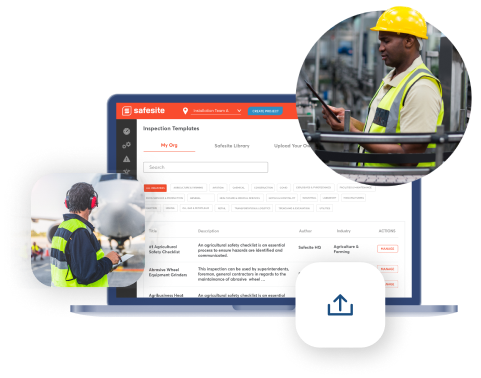Ladder Safety Toolbox Talk
Contributor: Safesite Jurisdiction: OSHA
Your team uses ladders all the time it's easy to forget the risks involved in using them. Use this toolbox talk to demonstrate the correct inspection, selection and uses of various types of ladders.

1. Ladders get you where you need to go, but using them safely is important. An uneven surface or damaged ladder could put you on the sidelines for weeks – even months. More than 24,000 injuries and 36 deaths occur every year in the US from ladder accidents, according to the Occupational Safety and Health Administration.
2. Checklist: Structural damage such as split or bent side rails
3. Checklist: Missing safety devices or broken rungs or steps
4. Checklist: Grease, dirt or other substances that could cause slips or falls
5. Checklist: Paint, tape or stickers, except warning labels, that could hide defects
6. Ladder Basics: Select the correct ladder for the task.
7. Ladder Basics: Place the ladder on a stable and level surface.
8. Ladder Basica: Extension ladders must extend at least three feet above the roof edge.
9. Ladder Basics: Ensure the ladder’s length will reach the work area.
10. Ladder Basics: Mark damaged ladders for replacement, or destroy them immediately.
11. Ladder Basics: Never load ladders beyond the maximum intended load or rated capacity.
12. Ladder Basics: Be sure the load rating can support the weight of the user and the job materials.
13. Ladder Basics: Avoid using metal ladders for electrical work or near overhead power lines.
14. Ladder Basics: Keep the area around the top and bottom of the ladder clear.
15. Ladder Basics: Never use the top step of a ladder.
16. Ladder Basics: Never carry your equipment or loads as you climb the ladder. Hoist the tools you need up and down.
17. Climb Safely: When climbing, face the ladder and use the hand-over- hand method, placing your hands on the rungs. Always maintain three points of contact.
18. Climb Safely: When using a stepladder, do not climb using the cross bracing on the back of the ladder.
19. Climb Safely: Do not tie or fasten ladders together to create longer sections.
20. Climb Safely: Ensure a metal spreader or locking device is on each stepladder to hold the front and back sections open when the ladder is being used.
21. Climb Safely: Make sure the ladder’s components will not cause punctures, lacerations or snag the user’s clothing.
22. Climb Safely: Ensure wooden ladders are not coated with any opaque covering, except for identification or warning labels.
23. Ladder Types: A portable ladder can be moved easily.
24. Ladder Types: A fixed ladder is an integral part of a structure and cannot be moved easily.
25. Ladder Types: A job-made ladder is made at the construction site.
26. Ladder Types: A through fixed ladder requires a person to step between the rails to reach the landing.
27. Ladder Types: A side-step fixed ladder requires a person to get off at the top to step to the side of the ladder’s side rails to reach the landing.
28. Ladder Types: A single-cleat ladder has a pair of side rails connected by cleats, rungs or steps.
29. Write Comments or Remarks here:
Additional Comments

Can't find what you are looking for?
